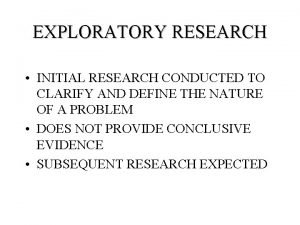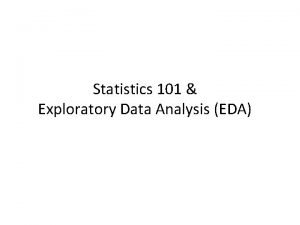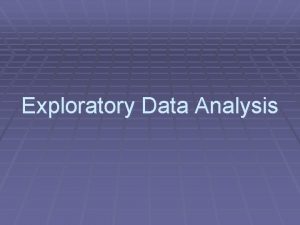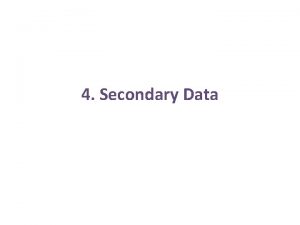Exploratory Research Design Secondary Data Chapter Outline 1
























- Slides: 24

Exploratory Research Design: Secondary Data

Chapter Outline 1) Overview 2) Primary versus Secondary Data 3) Advantages & Uses of Secondary Data 4) Disadvantages of Secondary Data

Chapter Outline (cont. ) 5) Criteria for Evaluating Secondary Data i. Specifications: Methodology Used to Collect the Data ii. Error: Accuracy of the Data iii. Currency: When the Data were collected iv. Objective(s): The Purpose for Which the Data were Collected v. Nature: The Content of the Data vi. Dependability: Overall, How Dependable are the Data

Chapter Outline 6) Classification of Secondary Data 7) Internal Secondary Data 8) Published External Secondary Sources i. General Business Sources a. Guides Census Data b. Directories c. Indexes d. Non-governmental Statistical Data

Chapter Outline ii. Government Sources a. Census Data b. Other Government Publications 9) Computerized Databases i. Classification of Computerized Databases ii. Directories of Databases 10) Syndicate Sources of Secondary Data

Chapter Outline 11) Syndicated Data from Households i. Surveys a. Psychographics & Lifestyles b. Advertising Evaluation c. General Surveys d. Uses of Surveys e. Advantages & Disadvantages of Surveys ii. Diary Panels a. Diary Purchase Panels b. Diary Media Panels c. Uses of Dairy Panels d. Advantages & Disadvantages of Dairy Panels iii. Electronic Scanner Services a. Volume Tracking Data b. Scanner Diary Panels c. Scanner Diary Panels with Cable TV d. Uses of Scanner Services e. Advantages & Disadvantages

Chapter Outline 12) Syndicated Data from Institutions i. Retailers & Wholesalers a. Uses of Audit Data b. Advantages & Disadvantages of Audit Data ii. Industry Services a. Uses of Industry Services b. Advantages & Disadvantages of Industry Services

Chapter Outline 13) Combining Information from Different Sources: Single-Source Data 14) Applications of Secondary Data i. Computer Mapping 15) International Marketing Research 16) Ethics in Marketing Research 17) Internet and Computer Applications 18) Focus on Burke 19) Summary 20) Key Terms & Concepts 21) Acronyms

Table 4. 1 A Comparison of Primary & Secondary Data Primary Data Collection purpose Collection process Collection cost Collection time For the problem at hand Very involved High Long Secondary Data For other problems Rapid & easy Relatively low Short

Table 4. 2 Criteria for Evaluating Secondary Data Criteria Issues Specifications Data collection method, response & methodology rate, quality & analysis of data, sampling technique & size, questionnaire design, field work. Examine errors in approach, Error & research design, sampling, data Accuracy collection & analysis, & reporting. Time lag between collection & Currency publication, frequency of updates. Why were the data collected? Objective Nature Dependability Definition of key variables, units of measurement, categories used, relationships examined. Expertise, credibility, reputation, & trustworthiness of the source. Remarks Data should be reliable, valid, & generalizable to the problem. Assess accuracy by comparing data from different sources. Census data are updated by syndicated firms. The objective determines the relevance of data. Reconfigure the data to increase their usefulness. Data should be obtained from an original source.

Fig. 4. 1 A Classification of Secondary Data Internal Ready to Use Requires Further Processing External Published Computerized Materials Databases Syndicated Services

RIP 4. 1 Type of Individual/Household Level Data Available from Syndicated Firms I. Demographic Data - Identification (name, address, telephone) - Sex - Marital status - Names of family members - Age (including ages of family members) - Income - Occupation - Number of children present - Home ownership - Length of residence - Number and make of cars owned

II. Psychographic Lifestyle Data - Interest in golf - Interest in snow skiing - Interest in book reading - Interest in running - Interest in bicycling - Interest in pets - Interest in fishing - Interest in electronics - Interest in cable television There also firms such as Dun & Bradstreet and American Business Information which collect demographic data on businesses.

Fig. 4. 2 A Classification of Published Secondary Sources Published Secondary Data General Business Sources Guides Directories Indexes Statistical Data Government Sources Census Other Data Government Publications

RIP 4. 2 American Business Information: Here, There, and Everywhere American Business Information Inc. markets subsets of its data in a number of forms, including the professional on-line services (LEXIS-NEXIS and DIALOG), the general online services (Compu. Serve and Microsoft Network), the Internet (look-ups), and on CD-ROM. The underlying database on which all these products are based contains information on 110 million residential listings and 11 million business listings. ABI also assigns credit scores to company listings. The ABI database most business researchers are familiar with are the American Business Directory and the Canadian Business Directory.

A Classification of Computerized Databases Fig. 4. 3 Computerized Databases On-Line Bibliographic Databases Numeric Databases Internet Full-Text Databases Off-Line Directory Databases Special. Purpose Databases

Fig. 4. 4 A Classification of Syndicated Services Unit of Measurement Households/ Consumers Institutions

Fig. 4. 4 Contd. Syndicated Services: Consumers Households / Consumers Mail Diary Panels Purchase Volume Tracking Data Surveys Psychographic & Lifestyles Media General Advertising Evaluation Electronic scanner services Scanner Diary Panels with Cable TV

Fig. 4. 4 Contd. Syndicated Services: Institutions Retailers Wholesalers Industrial firms Audits Direct Inquiries Clipping Services Corporate Reports

Table 4. 3 Overview of Syndicated Services

Table 4. 3 Contd.

RIP 4. 3 The New York Times on the Web: A New Way to Target Consumers The New York Times Electronic Media Company offers The New York Times on the Web database information to advertisers in a manner that enables firms to leverage the site’s 2 million registrants. The database contains demographic information, such as age, gender, income, and zip code, that ties to an e-mail address for each of the members. This new database marketing system can identify and customize user groups, target web messages to specific segments of the population, and adjust the message based on audience reaction. It can also increase targeting opportunities through third-party data or additional information supplied by the user.

For example, the database enables an automobile firm to emphasize safety to older customers, luxury to affluent ones, and roominess to families. The system is set up so that near real-time data can be received from the web that indicates how well ads are performing relative to age, gender, and income characteristics. Thus, this system allows a firm to maintain up-to-date information on audiences in order to position its products effectively.

Fig. 4. 5 A Classification of International Sources International Secondary Data Domestic Organizations in the United States Government Sources International Organizations in the United States Nongovernment Sources Governments Organizations in Foreign Countries International Organizations Trade Associations
 Criteria for evaluating secondary data
Criteria for evaluating secondary data Exploratory research secondary data
Exploratory research secondary data Types of exploratory research
Types of exploratory research Conclusive vs exploratory research
Conclusive vs exploratory research Define reseach
Define reseach Conclusive research
Conclusive research Projective techniques in exploratory research
Projective techniques in exploratory research Exploratory essay introduction
Exploratory essay introduction Exploratory research example
Exploratory research example Objectives of literature review
Objectives of literature review Exploratory research disadvantages
Exploratory research disadvantages Exploratory vs descriptive vs causal research
Exploratory vs descriptive vs causal research Refine the problem
Refine the problem What is research design?
What is research design? Experience survey in exploratory research
Experience survey in exploratory research Qualitative research procedures
Qualitative research procedures Exploratory research example
Exploratory research example Descriptive and causal inference
Descriptive and causal inference Difference between exploratory and conclusive research
Difference between exploratory and conclusive research Outline research design
Outline research design Characteristics of qualitative research
Characteristics of qualitative research Exploratory data analysis lecture notes
Exploratory data analysis lecture notes Define exploratory data analysis
Define exploratory data analysis Secondary data are
Secondary data are Syndicated sources of secondary data
Syndicated sources of secondary data












































